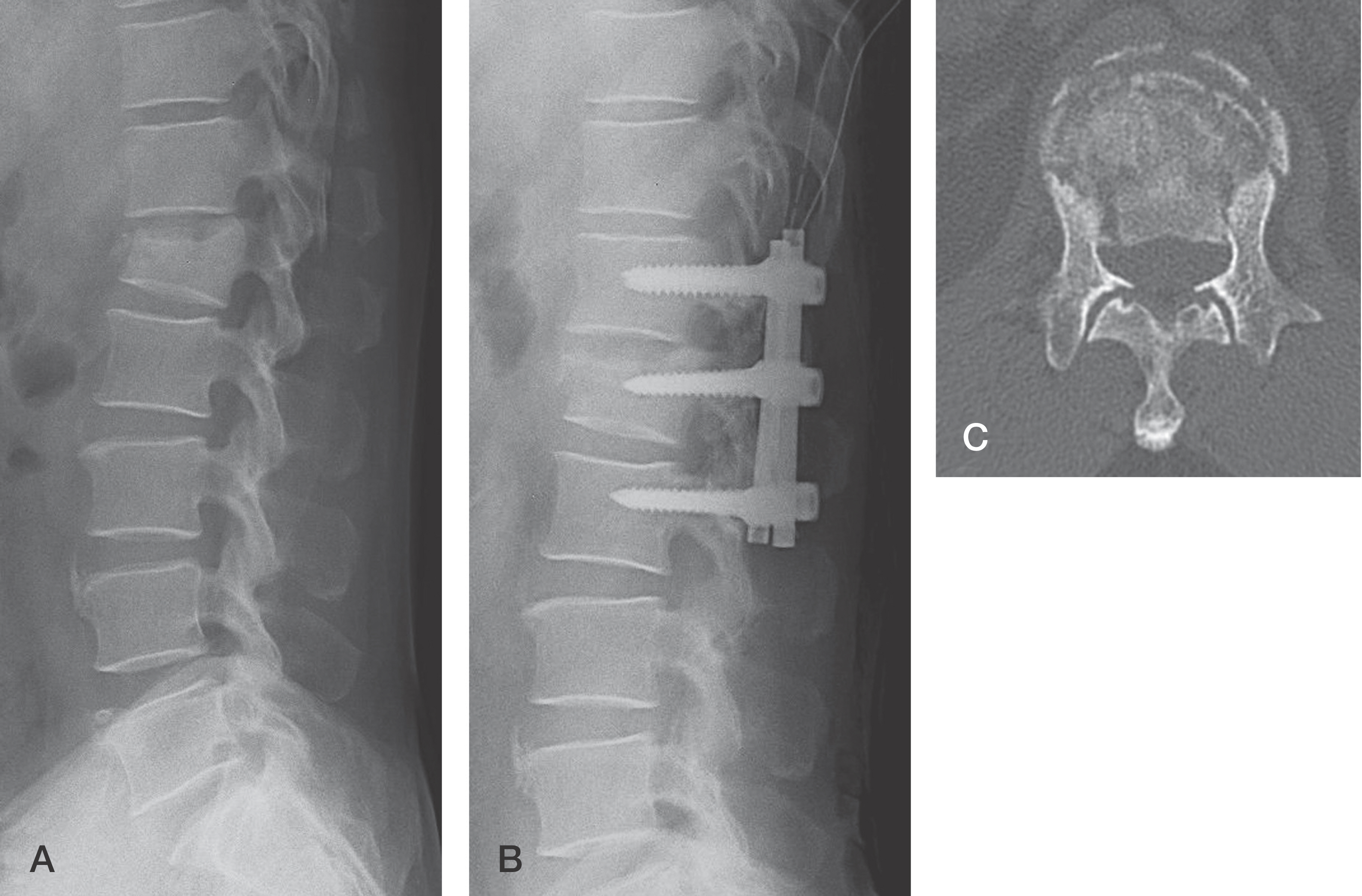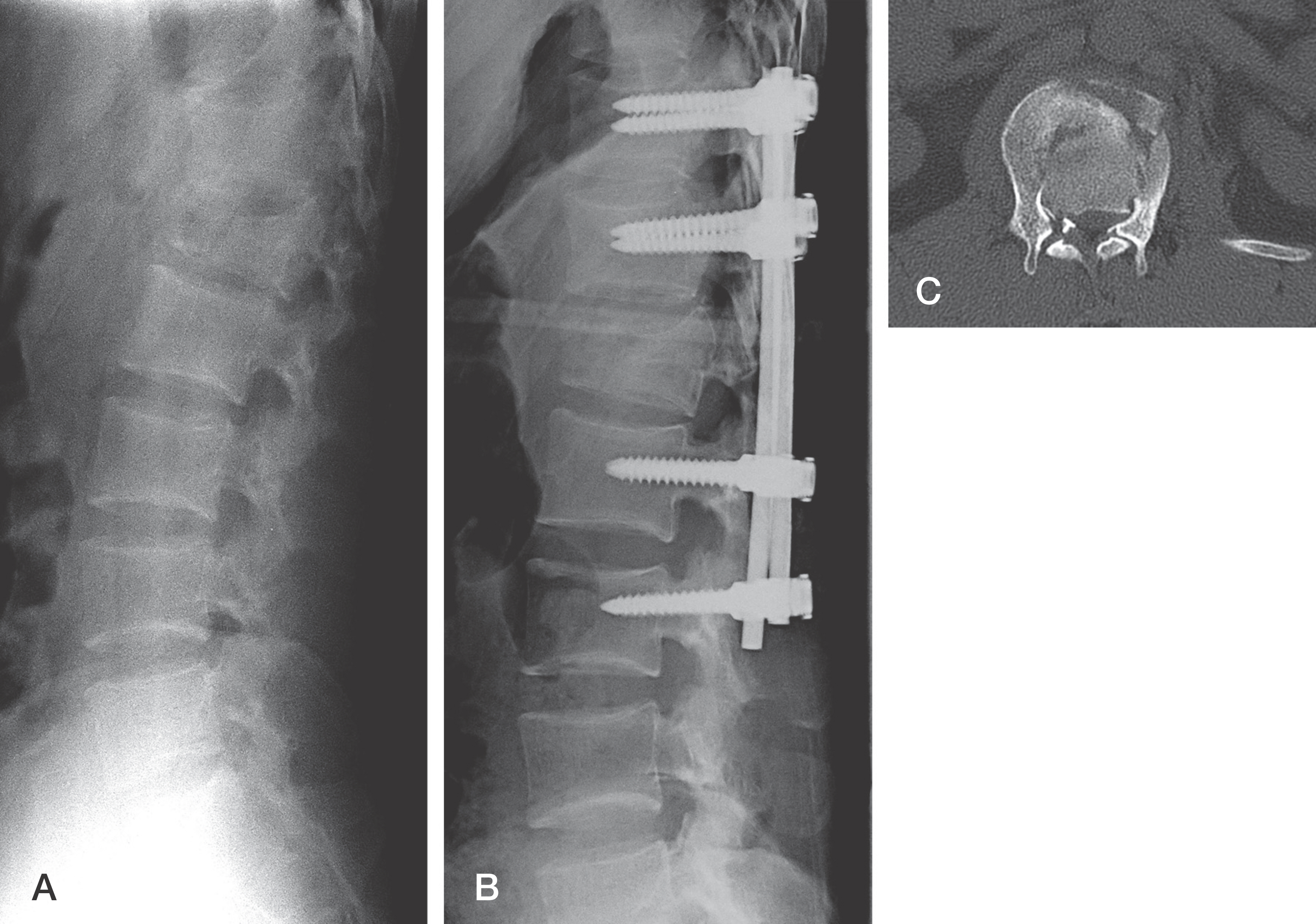J Korean Soc Spine Surg.
2015 Sep;22(3):92-98. 10.4184/jkss.2015.22.3.92.
The Outcomes of Short and Long Segment Posterior Instrumentation of Thoracolumbar Burst Fractures with a Load Sharing Score of 7 or More
- Affiliations
-
- 1Department of Orthopedic Surgery, College of Medicine, Dong A University, Korea. gylee@dau.ac.kr
- KMID: 2068926
- DOI: http://doi.org/10.4184/jkss.2015.22.3.92
Abstract
- STUDY DESIGN: Retrospective.
OBJECTIVES
To investigate outcomes between short and long segment posterior instrumentation of thoracolumbar burst fractures with a load sharing score of 7 or more. SUMMARY OF LITERATURE REVIEW: Short segment instrumentation has been recommended in thoracolumbar burst fractures with a load sharing score of 6 or less, and long segment instrumentation has been recommended for those with a score of 7 or more. However, this standard is controversial.
MATERIALS AND METHODS
From March 2006 to January 2014, 45 patients with thoracolumbar fractures with a load sharing score of 7 or more were treated with posterior instrumentation. They were divided into two groups: short (group S) and long segment (group L) groups. Radiologic results were evaluated on the basis of the kyphotic angle and anterior column height. Complications were also reviewed.
RESULTS
Groups S and L consisted of 13 and 32 patients and had mean ages of 48.3 and 47.3 years, respectively. In group S, the anterior column height increased from 56.62% to 76.23% postoperatively, and remained at 71.15% at follow-up. The kyphotic angle decreased from 16.27degrees to 7.55degrees postoperatively, and was 13.17degrees at follow-up. In group L, the anterior column height recovered from 49.67% to 70.52% postoperatively, and was 63.73% at follow-up. The kyphotic angle decreased from 20.08degrees to 6.80degrees postoperatively, and was 14.18degrees at follow-up. The changes in the anterior column height and kyphotic angle were not significantly different between groups S and L. Seven cases had complications and the number of cases with complications was not significantly different between groups S and L.
CONCLUSIONS
Short and long segment instrumentation of thoracolumbar fractures with a load sharing score of 7 or more did not achieve significantly different results.
Keyword
MeSH Terms
Figure
Reference
-
1. McLain RF. The biomechanics of long versus short fixation for thoracolumbar spine fractures. Spine(Phila Pa 1976). 2006; 31(Suppl):70–9.
Article2. Jeong ST, Cho SH, Song HR, et al. Comparison of Short and Long-Segment Fusion in Thoracic and Lumbar Fractures. J Korean Soc Spine Surg. 1999; 6:73–80.3. Mahar A, Kim C, Wedemeyer M, et al. Short-segment fixation of lumbar burst fractures using pedicle fixation at the level of the fracture. Spine(Phila Pa 1976). 2007; 32:1503–7.
Article4. McCormack T, Karaikovic E, Gaines RW. The load sharing classification of spine fractures. Spine (Phila Pa 1976). 1994; 19:1741–4.
Article5. Parker JW, Lane JR, Karaikovic EE, et al. Successful short-segment instrumentation and fusion for thoracolumbar spine fractures - A consecutive 4 (1)/(2)-year series. Spine(Phila Pa 1976). 2000; 25:1157–69.6. Lee KY, Sohn SK, Kim CH, et al. Posterior Short-Segment Instrumentation of Thoracic and Lumbar Bursting Fractures: Retrospective study related with Load-Sharing classification. J Korean Soc Spine Surg. 2001; 8:497–503.7. Altay M, Ozkurt B, Aktekin CN, et al. Treatment of un-stable thoracolumbar junction burst fractures with short- or longsegment posterior fixation in magerl type a fractures. Eur Spine J. 2007; 16:1145–55.
Article8. Na HY, Lee YS, Choi JC, et al. Comparison of Short Segment and Long Segment Posterior Instrumentation of Thoracolumbar and Lumbar Bursting Fractures at Load Sharing Score 7 or Above. J Korean Soc Spine Surg. 2013; 20:44–50.
Article9. Cotrel Y, Dubousset J, Guillaumat M. New universal instrumentation in spinal surgery. Clin Orthop Relat Res. 1988; 227:10–23.
Article10. Roy-Camille R, Saillant G, Mazel C. Internal fixation of the lumbar spine with pedicle screw plating. Clin Orthop Relat Res. 1986; 203:7–17.
Article11. McLain RF, Sparling E, Benson DR. Early failure of short-segment pedicle instrumentation for thoracolumbar fractures. A preliminary report. J Bone Joint Surg Am. 1993; 75:162–7.
Article12. Chung JY RI. Short segment transpedicular Cotrel-Dubousset instrumentation including involved vertebra for fractures of thoracic and lumbar spine. J Korean Orthop Assoc. 1994; 29:940–8.
Article13. Lee YS, Sung JK. Longterm Followup Results of Short-segment Posterior Screw Fixation for Thoracolumbar Burst Fractures. J Korean Neurosurg Soc. 2005; 37:416–21.14. Lee CS, Chung SS, Jung HW, et al. Decision of Posterior Fixation Level by Load-Sharing Classification in Thoracolumbar and Lumbar Burst Fracture. J Korean Soc Spine Surg. 2001; 8:27–38.
Article15. Kim CH, Hwang JK, Choi YJ, et al. Treatment of Thoraco-Lumbar Bursting Fractures According to Load-Sharing Classification. J Korean Fract Soc. 2005; 18:69–75.
Article16. Wei FX, Liu SY, Liang CX, et al. Transpedicular fixation in management of thoracolumbar burst fractures: monosegmental fixation versus short-segment instrumentation. Spine (Phila Pa 1976). 2010; 35:E714–20.17. James KS, Wenger KH, Schlegel JD, et al. Biomechanical evaluation of the stability of thoracolumbar burst fractures. Spine (Phila Pa 1976). 1994; 19:1731–40.
Article18. Alanay A, Yazici M, Acaroglu E, et al. Course of nonsurgical management of burst fractures with intact posterior ligamentous complex: an MRI study. Spine (Phila Pa 1976). 2004; 29:2425–31.
Article19. Radcliff K, Kepler CK, Rubin TA, et al. Does the load-sharing classification predict ligamentous injury, neurological injury, and the need for surgery in patients with thoracolumbar burst fractures? J Neurosurg Spine. 2012; 16:534–8.
Article20. Kim WC, Lee KY, Wang L, et al. The Analysis of the Outcome of Short- and Long-Segment Posterior Instrumentation for Thoracolumbar Bursting Fractures. J Korean Soc Spine Surg. 2014; 21:139–45.
Article21. Willen J, Anderson J, Toomoka K, et al. The natural history of burst fractures at the thoracolumbar junction. J Spinal Disord. 1990; 3:39–46.
Article22. Pau A, Silvestro C, Carta F. Can lacerations of the thoracolumbar dura be predicted on the basis of radiological patterns of the spinal fractures? Acta Neurochir (Wien). 1994; 129:186–7.
Article23. Silvestro C, Francaviglia N, Bragazzi R, et al. On the predictive value of radiological signs for the presence of dural lacerations related to fractures of the lower thoracic or lumbar spine. J Spinal Disord. 1991; 4:49–53.
- Full Text Links
- Actions
-
Cited
- CITED
-
- Close
- Share
- Similar articles
-
- Comparison of Short Segment and Long Segment Posterior Instrumentation of Thoracolumbar and Lumbar Bursting Fractures at Load Sharing Score 7 or Above
- More than 5-Year Follow-up Results of Two-Level and Three-Level Posterior Fixations of Thoracolumbar Burst Fractures with Load-Sharing Scores of Seven and Eight Points
- Radiological Outcome of Short Segment Posterior Instrumentation and Fusion for Thoracolumbar Burst Fractures
- Decision of Posterior Fixation Level by Load-Sharing Classification in Thoracolumbar and Lumbar Burst Fracture
- Relationships Between Canal Occlusion and Neurologic Deficits, and Between Kyphotic Deformities and Fracture Types in Unstable Thoracolumbar Burst Fractures



